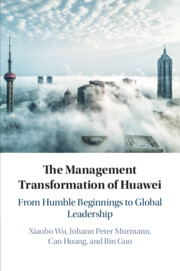Book contents
- The Management Transformation of Huawei
- The Management Transformation of Huawei
- Copyright page
- Contents
- Figures
- Tables
- Contributors
- Preface
- 1 The Management Transformation of Huawei
- 2 The Executive Management Team and Organizational Change
- 3 Transforming Product Development at Huawei
- 4 Huawei’s Transformation of Supply Chain Management
- 5 Financial Management Transformation in Huawei
- 6 The Transformation of Huawei’s HR System
- 7 Huawei’s Internationalization Journey
- 8 Huawei’s R&D Management Transformation
- 9 Huawei’s Intellectual Property Management Transformation
- 10 The Management Transformation of Huawei
- Book part
- Index
- References
2 - The Executive Management Team and Organizational Change
A Routinized Transformation Perspective
Published online by Cambridge University Press: 21 March 2020
- The Management Transformation of Huawei
- The Management Transformation of Huawei
- Copyright page
- Contents
- Figures
- Tables
- Contributors
- Preface
- 1 The Management Transformation of Huawei
- 2 The Executive Management Team and Organizational Change
- 3 Transforming Product Development at Huawei
- 4 Huawei’s Transformation of Supply Chain Management
- 5 Financial Management Transformation in Huawei
- 6 The Transformation of Huawei’s HR System
- 7 Huawei’s Internationalization Journey
- 8 Huawei’s R&D Management Transformation
- 9 Huawei’s Intellectual Property Management Transformation
- 10 The Management Transformation of Huawei
- Book part
- Index
- References
Summary
The chapter discusses the crucial role that top management team played at Huawei to initiate, implement, and routinize organizational transformation. Huawei’s leadership always had a strong long-term orientation and it tried to strike a careful balance between dynamics and stability. It also relied very heavily on Western consulting firms to transfer best practice to Huawei. The chapter also documents Huawei’s constant structural transformation of the top management team since 1998 with the expansion of the firm. Huawei maintained strategic consistency by creating a new executive management team structure 2003 that relieved an overburdened CEO position through a more collective decision making process and later in 2011 by instituting a rotating CEO arrangement. A number of lessons from Huawei’s experience are identified that provide guidance for firms to facilitate organization transformation as they rise and face more global competition.
Keywords
- Type
- Chapter
- Information
- The Management Transformation of HuaweiFrom Humble Beginnings to Global Leadership, pp. 71 - 109Publisher: Cambridge University PressPrint publication year: 2020
References
References
References
- 1
- Cited by

